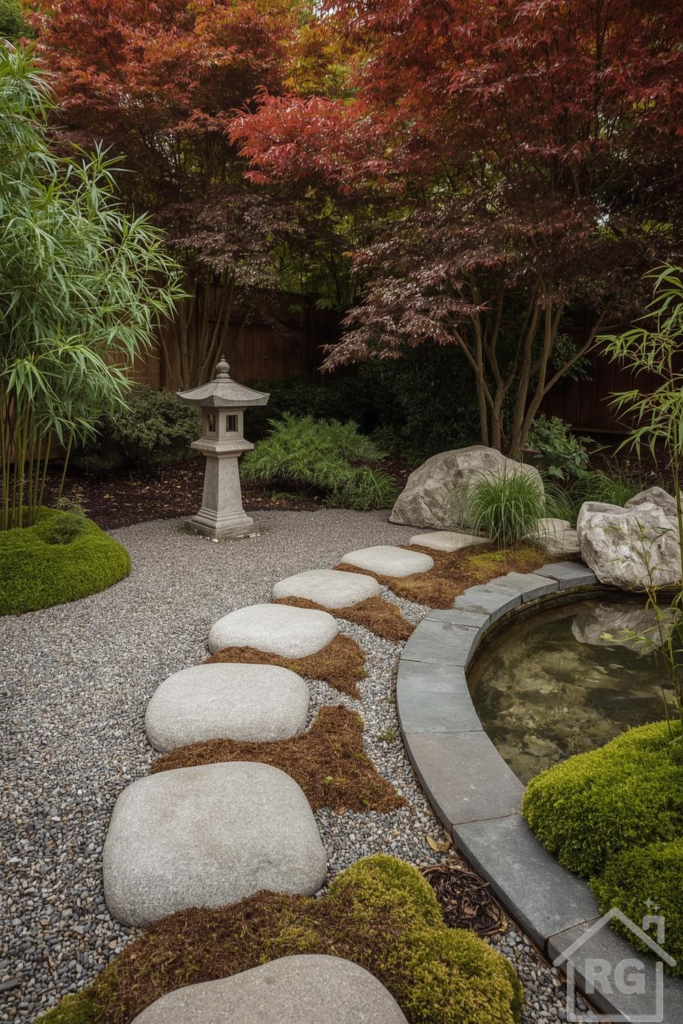
There’s an undeniable allure to the Zen garden — a space meticulously crafted to evoke tranquility, contemplation, and a deep connection with nature.
When infused with the rich, warm hues of autumn, a Zen garden transforms into an even more captivating sanctuary. This guide will walk you through the essential elements and design principles to help you replicate serene beauty, creating your own peaceful retreat that thrives through the changing seasons.
The Philosophy Behind a Zen Garden
Before diving into the practicalities, understanding the core philosophy of a Zen garden, or ‘karesansui’ (dry landscape garden), is crucial. These gardens are not merely decorative; they are intended as places for meditation and reflection. Key principles include:
- Simplicity (Kanso): Eliminating clutter to highlight essential elements.
- Naturalness (Shizen): Embracing organic forms and materials, avoiding artificiality.
- Asymmetry (Fukinsei): Achieving balance through irregular, non-symmetrical arrangements, mirroring nature’s imperfections.
- Tranquility (Seijaku): Fostering a sense of calm and quiet.
- Austerity (Koko): Stripping away the superfluous to reveal inner beauty.
By keeping these principles in mind, every design choice, from the placement of a stone to the selection of a plant, contributes to the garden’s overall meditative atmosphere.
Key Elements of This Autumn Zen Garden Design
Hardscaping: The Foundation of Form and Flow
The hardscaping elements in a Zen garden provide its structure and define its pathways. In the featured image, the interplay of gravel, stepping stones, boulders, and a water feature creates a dynamic yet harmonious landscape.
- Gravel (Dry Landscape): The vast expanse of fine, dark grey pea gravel serves as the ‘water’ element in this dry landscape, often raked into patterns symbolizing ripples or currents. For your garden, ensure proper drainage by laying down a weed barrier fabric before spreading a 2-4 inch layer of gravel. Consider different shades of grey or even subtle browns to complement your palette.
- Stepping Stones: The large, smooth, light grey stepping stones create an inviting path, guiding the eye and the foot through the garden. These ‘tobi-ishi’ (flying stones) should be placed irregularly but with a natural rhythm, encouraging a slow, deliberate pace. Choose natural river stones or pre-cast concrete pavers that mimic their organic shape. Ensure they are firmly set into the gravel or ground to prevent wobbling.
- Pond/Water Feature: The serene pond, edged with dark grey bluestone, introduces a vital element of ‘living water’ to the scene. The gentle reflections and potential for subtle sounds add to the garden’s tranquility. When designing a pond, consider its size relative to your space, ensure proper filtration, and select durable pond liners. The bluestone edging provides a clean, sophisticated border that complements the natural stone elements.
- Boulders: Strategically placed natural boulders, like the large, rough grey ones near the pond, act as focal points or ‘islands’ in the gravel sea. Their placement should appear effortless and organic, as if they have always been there. Choose stones with interesting textures and shapes, arranging them in odd-numbered groupings for a natural, asymmetrical look.
Plant Selection: Adding Life and Seasonal Beauty
The plant palette in a Zen garden is typically restrained, focusing on texture, form, and seasonal interest rather than an abundance of flowers. The autumn colors in the image are primarily provided by the Japanese maples.
- Japanese Maples (Acer palmatum): These iconic trees are central to the autumn aesthetic, offering breathtaking crimson, fiery red, and deep burgundy foliage. Varieties like ‘Bloodgood’ or ‘Osakazuki’ are renowned for their intense autumn color. When selecting, consider their mature size and shape. They thrive in well-drained soil and prefer partial shade, especially in hotter climates, to prevent leaf scorch. Their delicate branches and elegant form make them perfect specimens for a Zen garden.
- Bamboo: The tall, slender green bamboo provides a vertical element and a sense of enclosure, creating a natural screen. Choose clumping varieties (e.g., Fargesia species) to prevent invasive spreading, or use root barriers for running types. Bamboo adds a subtle rustling sound in the breeze, enhancing the sensory experience.
- Moss: The lush, vibrant green moss, alongside patches of dried brown moss, adds incredible texture and a sense of age to the garden. Moss thrives in damp, shady conditions and can be cultivated on stones, soil, or even in dedicated moss gardens. Different types, such as cushion moss or sheet moss, offer varied textures. It’s a low-maintenance groundcover once established, requiring consistent moisture.
- Other Greenery: Low-growing evergreen shrubs and groundcovers, like those seen in the background, provide year-round structure and a calming green backdrop. Consider dwarf conifers, ferns, or mondo grass for their subtle textures and forms.
Decorative Elements: Subtle Accents
Decorative elements in a Zen garden are minimal and purposeful, often carrying symbolic meaning.
- Stone Lanterns: The traditional stone lantern (ishidōrō) is a classic feature, symbolizing enlightenment and guiding light. While often purely decorative in a modern Zen garden, they can be fitted with subtle lighting for evening ambiance. Types like the ‘Kasuga’ (as seen in the image) or ‘Yukimi’ (snow-viewing) add an authentic touch.
Creating Atmosphere and Flow
Beyond individual elements, it’s how they interact that defines a Zen garden’s atmosphere.
- Pathways: The winding path of stepping stones encourages a slow, contemplative journey through the garden, inviting visitors to pause and observe. Design your path to reveal new perspectives as one moves through the space.
- Balance and Asymmetry: Embrace the principle of ‘fukinsei’ by arranging elements in an unbalanced yet harmonious way. For instance, a large boulder might be balanced by a cluster of smaller plants, rather than a mirror image.
- Sound: The gentle rustle of bamboo, the subtle splash of water from the pond, or even the crunch of gravel underfoot contribute to the sensory experience, enhancing the garden’s tranquility.
- Lighting: While the image shows a decorative lantern, consider subtle, low-voltage landscape lighting to highlight key features like the Japanese maples or the pond at night. Avoid harsh, bright lights that disrupt the peaceful ambiance.
Material Choices for Durability and Authenticity
Choosing the right materials ensures your Zen garden is not only beautiful but also long-lasting and authentic.
- Stone: Natural stone for stepping stones, boulders, and pond edging is paramount. It offers unparalleled durability and a timeless aesthetic that blends seamlessly with the natural environment. Look for local stone suppliers for cost-effective and regionally appropriate options.
- Gravel: Opt for high-quality pea gravel or crushed granite for your dry landscape areas. These materials compact well, provide good drainage, and are easy to rake into patterns.
- Wood: If incorporating wooden elements like fences (as seen in the background) or benches, choose naturally rot-resistant woods like cedar or redwood. These will weather beautifully over time, developing a soft, silvery patina.
DIY Tips for Your Zen Garden Project
Creating a Zen garden can be a rewarding DIY project. Here are some tips:
- Site Preparation: Clear the area of weeds and debris. Level the ground and install a high-quality landscape fabric to suppress future weed growth before adding gravel.
- Stepping Stone Installation: Dig shallow depressions for each stone, ensuring they are level and stable. For gravel paths, you can simply set them firmly into the gravel, ensuring they don’t rock.
- Moss Cultivation: To encourage moss growth, create a slurry of moss, buttermilk, and water, then paint it onto desired surfaces (stones, soil). Keep the area consistently moist and shaded.
- Pond Liner: For a simple pond, use a flexible pond liner. Excavate the pond shape, add a layer of sand or underlayment to protect the liner, then lay the liner, securing the edges with stones or soil.
Maintenance for a Lasting Zen Sanctuary
While Zen gardens are designed for low maintenance, some care is essential to preserve their beauty:
- Weeding: Regularly remove any weeds that sprout in the gravel or moss areas. A small hand rake or weeding tool is ideal.
- Pond Care: Keep the pond water clean and clear. This may involve skimming debris, cleaning filters, and occasionally topping up water levels.
- Pruning: Prune Japanese maples to maintain their elegant form and remove any dead or crossing branches. Bamboo may require occasional thinning to prevent it from becoming too dense.
- Moss Care: Ensure moss areas remain moist, especially during dry spells. Mist them regularly if necessary.
Conclusion: Your Personal Autumn Zen Retreat
By thoughtfully incorporating these elements and principles, you can create an autumn Zen garden that is not only visually stunning but also a profound source of peace and contemplation.
Imagine the vibrant crimson and burgundy leaves of your Japanese maples contrasting with the serene grey of the stones and the deep green of the moss and bamboo. This space will become your personal sanctuary, a place to unwind, meditate, and connect with the timeless beauty of nature, especially as the crisp air of autumn settles in. Enjoy the journey of creating your own tranquil retreat!
